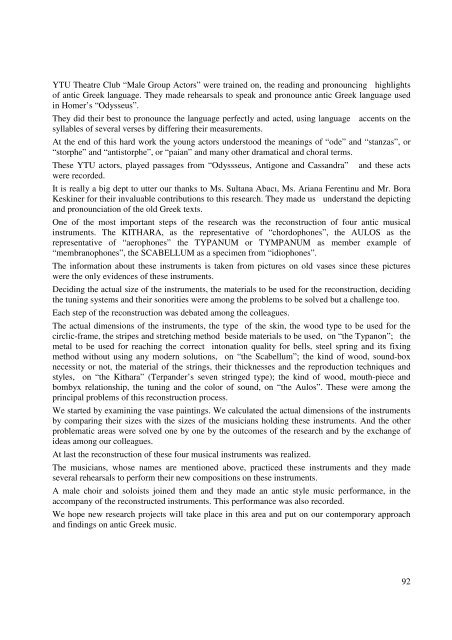ERATO Proceedings Istanbul 2006.pdf - Odeon
ERATO Proceedings Istanbul 2006.pdf - Odeon
ERATO Proceedings Istanbul 2006.pdf - Odeon
You also want an ePaper? Increase the reach of your titles
YUMPU automatically turns print PDFs into web optimized ePapers that Google loves.
YTU Theatre Club “Male Group Actors” were trained on, the reading and pronouncing highlights<br />
of antic Greek language. They made rehearsals to speak and pronounce antic Greek language used<br />
in Homer’s “Odysseus”.<br />
They did their best to pronounce the language perfectly and acted, using language accents on the<br />
syllables of several verses by differing their measurements.<br />
At the end of this hard work the young actors understood the meanings of “ode” and “stanzas”, or<br />
“storphe” and “antistorphe”, or “paian” and many other dramatical and choral terms.<br />
These YTU actors, played passages from “Odyssseus, Antigone and Cassandra”<br />
were recorded.<br />
and these acts<br />
It is really a big dept to utter our thanks to Ms. Sultana Abacı, Ms. Ariana Ferentinu and Mr. Bora<br />
Keskiner for their invaluable contributions to this research. They made us understand the depicting<br />
and pronounciation of the old Greek texts.<br />
One of the most important steps of the research was the reconstruction of four antic musical<br />
instruments. The KITHARA, as the representative of “chordophones”, the AULOS as the<br />
representative of “aerophones” the TYPANUM or TYMPANUM as member example of<br />
“membranophones”, the SCABELLUM as a specimen from “idiophones”.<br />
The information about these instruments is taken from pictures on old vases since these pictures<br />
were the only evidences of these instruments.<br />
Deciding the actual size of the instruments, the materials to be used for the reconstruction, deciding<br />
the tuning systems and their sonorities were among the problems to be solved but a challenge too.<br />
Each step of the reconstruction was debated among the colleagues.<br />
The actual dimensions of the instruments, the type of the skin, the wood type to be used for the<br />
circlic-frame, the stripes and stretching method beside materials to be used, on “the Typanon”; the<br />
metal to be used for reaching the correct intonation quality for bells, steel spring and its fixing<br />
method without using any modern solutions, on “the Scabellum”; the kind of wood, sound-box<br />
necessity or not, the material of the strings, their thicknesses and the reproduction techniques and<br />
styles, on “the Kithara” (Terpander’s seven stringed type); the kind of wood, mouth-piece and<br />
bombyx relationship, the tuning and the color of sound, on “the Aulos”. These were among the<br />
principal problems of this reconstruction process.<br />
We started by examining the vase paintings. We calculated the actual dimensions of the instruments<br />
by comparing their sizes with the sizes of the musicians holding these instruments. And the other<br />
problematic areas were solved one by one by the outcomes of the research and by the exchange of<br />
ideas among our colleagues.<br />
At last the reconstruction of these four musical instruments was realized.<br />
The musicians, whose names are mentioned above, practiced these instruments and they made<br />
several rehearsals to perform their new compositions on these instruments.<br />
A male choir and soloists joined them and they made an antic style music performance, in the<br />
accompany of the reconstructed instruments. This performance was also recorded.<br />
We hope new research projects will take place in this area and put on our contemporary approach<br />
and findings on antic Greek music.<br />
92
















